
- Homepage
- Author
- Arthur Von Mayer (15)
- Bram Stoker (8)
- Charles Dickens (9)
- Dan Brown (7)
- Dr. Seuss (18)
- Ernest Hemingway (9)
- Francois Coppee (7)
- Frank Herbert (9)
- George Orwell (12)
- Howe, George (6)
- J.k. Rowling (44)
- J.r.r. Tolkien (16)
- Kurban Said (6)
- L. Frank Baum (9)
- Margaret Mitchell (8)
- Mark Twain (8)
- Robert Paul Smith (6)
- Rudyard Kipling (16)
- Stephen King (28)
- Wendell Berry (9)
- Other (2675)
- Binding
- Language
- Region
- Topic
- Action, Adventure (21)
- American (us) (12)
- Christianity, Bibles (23)
- Classics (130)
- Fantasy (28)
- Fiction (13)
- Historical (91)
- Horror (22)
- Literature (148)
- Literature, Modern (19)
- Mystery, Thriller (25)
- Novels (41)
- Occult (84)
- Photography (18)
- Poetry (41)
- Political (13)
- Religion (20)
- Science Fiction (29)
- Sets (18)
- Travel (12)
- Other (2117)
- Year Printed
WINNIE THE POOH! (FIRST EDITION/FIRST PRINTING! 1926!) Methuen London Milne RARE
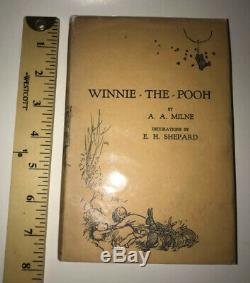
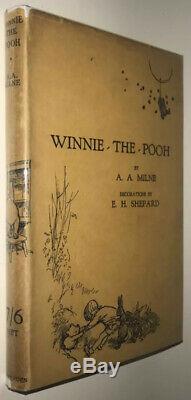
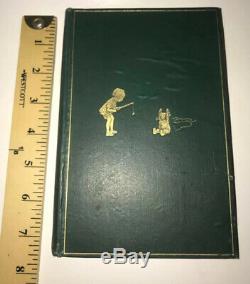
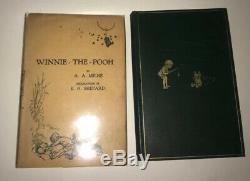
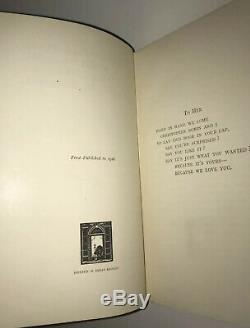
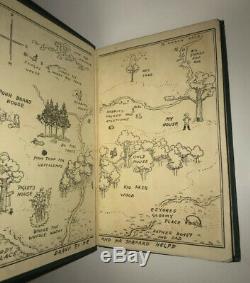
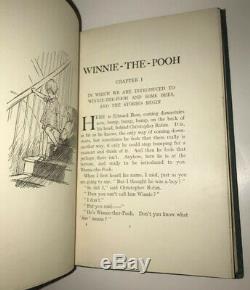

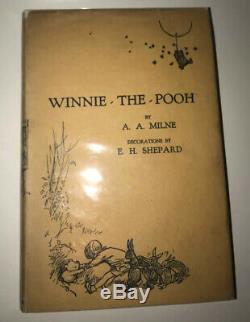
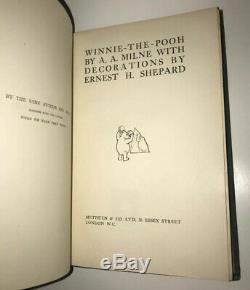

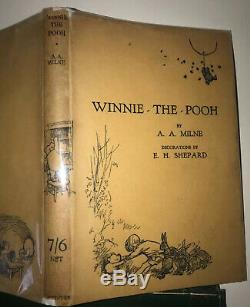


This is the most desirable form of this book. Exceedingly well preserved for such a beloved children's book.
The True First Edition/First Printing! Printed by by Methuen & Company, London. FIRST EDITION/FIRST PRINTING of Winnie the Pooh.
The dust jacket is a later printing of the First Edition. This book is almost 100 years old. In far better condition than is to be expected. This is the more desirable British Edition, printed by Methuen. The True First Edition/First Printing. Bound in the original cloth binding. CONDITION: This is the rare and highly desirable First Edition/First Printing. This book is complete In exceptional condition for such a beloved children's book. With some generalized usage wear from use, but still very presentable. Some bubbling and wear to the cover. The dust jacket has some extremity chipping. The dust jacket is a later issue, hence the low price. Some external wear to the binding, some of which is visible in the pictures, so please review the pictures, wear at the head of spine, some abrasions. In exceptional condition compared to other copies, and fairly clean. A gorgeous copy, of a highly desirable First Edition. From Wikipedia, the free encyclopedia. For other uses, see Pooh (disambiguation). This article is about the original version of Winnie-the-Pooh.For the Disney version of this character, see Winnie the Pooh (Disney character). For the songwriter, see Poo Bear. For other uses, see Winnie-the-Pooh (disambiguation).
Pooh in an illustration by E. When We Were Very Young. (1924) (As Edward Bear) Winnie-the-Pooh. Winnie-the-Pooh , also called Pooh Bear , is a fictional anthropomorphic. Created by English author A.
The first collection of stories about the character was the book Winnie-the-Pooh. (1926), and this was followed by The House at Pooh Corner. Milne also included a poem about the bear in the children's verse book When We Were Very Young.
(1924) and many more in Now We Are Six. All four volumes were illustrated by E. The Pooh stories have been translated into many languages, including Alexander Lenard. Translation, Winnie ille Pu , which was first published in 1958, and, in 1960, became the only Latin. In the character's name were omitted by Disney.
When the company adapted the Pooh stories into a series of features. That would eventually become one of its most successful franchises. In popular film adaptations, Pooh has been voiced by actors Sterling Holloway. In English, and Yevgeny Leonov. Ashdown Forest: the setting for the stories.Clockwise from bottom left: Tigger. Was lost long ago; the other characters were made up for the stories. Named the character Winnie-the-Pooh after a teddy bear owned by his son, Christopher Robin Milne. On whom the character Christopher Robin.
The rest of Christopher Robin Milne's toys Piglet. Were incorporated into Milne's stories. Were created by Milne's imagination, while Gopher.
Was added to the Disney version. Christopher Robin's toy bear is on display at the Main Branch of the New York Public Library.
Harry Colebourn and Winnie, 1914. Christopher Milne had named his toy bear after Winnie. He often saw at London Zoo. And "Pooh", a swan they had met while on holiday. Canada, while en route to England during the First World War.
He named the bear "Winnie" after his adopted hometown in Winnipeg. "Winnie" was surreptitiously brought to England with her owner, and gained unofficial recognition as The Fort Garry Horse.
Colebourn left Winnie at the London Zoo while he and his unit were in France; after the war she was officially donated to the zoo, as she had become a much-loved attraction there. Pooh the swan appears as a character in its own right in When We Were Very Young. Of Harry Colebourn and Winnie. In the first chapter of Winnie-the-Pooh. Milne offers this explanation of why Winnie-the-Pooh is often called simply "Pooh".
The American writer William Safire. Surmised that the Milnes' invention of the name "Winnie the Pooh" may have also been influenced by the haughty character Pooh-Bah. The Winnie-the-Pooh stories are set in Ashdown Forest. The forest is an area of tranquil open heathland on the highest sandy ridges of the High Weald Area of Outstanding Natural Beauty. Situated 30 miles (50 km) south-east of London.
In 1925 Milne, a Londoner, bought a country home a mile to the north of the forest at Cotchford Farm. According to Christopher Milne, while his father continued to live in London... The four of us he, his wife, his son and his son's nanny would pile into a large blue, chauffeur-driven Fiat and travel down every Saturday morning and back again every Monday afternoon. And we would spend a whole glorious month there in the spring and two months in the summer.
From the front lawn the family had a view across a meadow to a line of alders. That fringed the River Medway.
Beyond which the ground rose through more trees until finally above them, in the faraway distance, crowning the view, was a bare hilltop. In the centre of this hilltop was a clump of pines. " Most of his father's visits to the forest at that time were, he noted, family expeditions on foot "to make yet another attempt to count the pine trees on Gill's Lap or to search for the marsh gentian. Christopher added that, inspired by Ashdown Forest, his father had made it "the setting for two of his books, finishing the second little over three years after his arrival".Many locations in the stories can be associated with real places in and around the forest. As Christopher Milne wrote in his autobiography: "Poohs forest and Ashdown Forest are identical". For example, the fictional Hundred Acre Wood. Was in reality Five Hundred Acre Wood; Galleon's Leap was inspired by the prominent hilltop of Gill's Lap, while a clump of trees just north of Gill's Lap became Christopher Robin's The Enchanted Place , because no-one had ever been able to count whether there were 63 or 64 trees in the circle.
The landscapes depicted in E. S illustrations for the Winnie-the-Pooh books were directly inspired by the distinctive landscape of Ashdown Forest, with its high, open heathlands of heather, gorse, bracken and silver birch, punctuated by hilltop clumps of pine trees.Many of Shepard's illustrations can be matched to actual views, allowing for a degree of artistic licence. Shepard's sketches of pine trees and other forest scenes are held at the Victoria and Albert Museum. Was originally played by Christopher Milne on a footbridge across a tributary of the River Medway in Posingford Wood, close to Cotchford Farm. The wooden bridge is now a tourist attraction, and it has become traditional to play the game there using sticks gathered in the nearby woodland.
When the footbridge had to be replaced in 1999, the engineer designed a new structure based closely on the drawings of the bridge by Shepard in the books, which were somewhat different from the original structure. Winnie-the-Pooh's debut in the. Christopher Robin's teddy bear, Edward, made his character début in A. Milne's poem, "Teddy Bear", in the edition of 13 February 1924 of Punch.
And the same poem was published in Milne's book of children's verse When We Were Very Young. Winnie-the-Pooh first appeared by name on 24 December 1925, in a Christmas story commissioned and published by the London newspaper The Evening News. It was illustrated by J.The first collection of Pooh stories appeared in the book Winnie-the-Pooh. The Evening News Christmas story reappeared as the first chapter of the book. At the beginning, it explained that Pooh was in fact Christopher Robin's Edward Bear, who had been renamed by the boy. He was renamed after an American black bear at London Zoo.
Called Winnie who got her name from the fact that her owner had come from Winnipeg, Canada. The book was published in October 1926 by the publisher of Milne's earlier children's work, Methuen. In the United States, and McClelland & Stewart. In the Milne books, Pooh is naive and slow-witted, but he is also friendly, thoughtful and steadfast.
Although he and his friends agree that he "has no Brain", Pooh is occasionally acknowledged to have a clever idea, usually driven by common sense. These include riding in Christopher Robin's umbrella to rescue Piglet from a flood, discovering "the North Pole" by picking it up to help fish Roo out of the river, inventing the game of Poohsticks.
And getting Eeyore out of the river by dropping a large rock on one side of him to wash him towards the bank. Pooh is also a talented poet and the stories are frequently punctuated by his poems and "hums".
Although he is humble about his slow-wittedness, he is comfortable with his creative gifts. When Owl's house blows down in a windstorm, trapping Pooh, Piglet and Owl inside, Pooh encourages Piglet (the only one small enough to do so) to escape and rescue them all by promising that "a respectful Pooh song" will be written about Piglet's feat. Later, Pooh muses about the creative process as he composes the song. Pooh is very fond of food, particularly hunny. , but also condensed milk and other items.When he visits friends, his desire to be offered a snack is in conflict with the impoliteness of asking too directly. Though intent on giving Eeyore a pot of honey for his birthday, Pooh could not resist eating it on his way to deliver the present and so instead gives Eeyore "a useful pot to put things in". When he and Piglet are lost in the forest during Rabbit's attempt to "unbounce" Tigger, Pooh finds his way home by following the "call" of the honeypots from his house. Pooh makes it a habit to have "a little something" around 11:00 in the morning.
As the clock in his house "stopped at five minutes to eleven some weeks ago, " any time can be Pooh's snack time. After Christopher Robin, his closest friend is Piglet, and he most often chooses to spend his time with one or both of them. But he also habitually visits the other animals, often looking for a snack or an audience for his poetry as much as for companionship.
His kind-heartedness means he goes out of his way to be friendly to Eeyore, visiting him and bringing him a birthday present and building him a house, despite receiving mostly disdain from Eeyore in return. An authorised sequel Return to the Hundred Acre Wood. Was published on 5 October 2009. Has developed, but not changed, Milne's characterisations. The illustrations, by Mark Burgess. Are in the style of Shepard. Another authorised sequel, Winnie-the-Pooh: The Best Bear in All the World. The sequel consists of four short stories by four leading children's authors, Kate Saunders. Paul Bright and Jeanne Willis.Illustrations are by Mark Burgess. The Best Bear in All The World sees the introduction of a new character, a Penguin, which was inspired by a long-lost photograph of Milne and his son Christopher with a toy penguin. A further special story, Winnie-the-Pooh Meets the Queen. Was published in 2016 to mark the 90th anniversary of Milne's creation and the 90th birthday of Elizabeth II.
It sees Winnie the Pooh meet the Queen at Buckingham Palace. On 6 January 1930, Stephen Slesinger. Slesinger marketed Pooh and his friends for more than 30 years, creating the first Pooh doll, record, board game, puzzle, U. Radio broadcast (NBC), animation and motion picture film.The first time Pooh and his friends appeared in colour was 1932, when he was drawn by Slesinger in his now-familiar red shirt and featured on an RCA Victor. Milne's Winnie-the-Pooh Game in 1933, again with Pooh in his red shirt. In the 1940s, Agnes Brush created the first plush dolls with Pooh in his red shirt.
Shepard had drawn Pooh with a shirt as early as the first Winnie-The-Pooh book, which was subsequently coloured red in later coloured editions. Main articles: Winnie the Pooh (franchise). And Winnie the Pooh (Disney character). After Slesinger's death in 1953, his wife, Shirley Slesinger Lasswell.
Continued developing the character herself. In 1961, she licensed rights to Walt Disney Productions. Milne's widow, Daphne Milne, also licensed certain rights, including motion picture rights, to Disney.
Since 1966, Disney has released numerous animated productions starring Winnie the Pooh. And related characters, starting with the theatrical featurette. Winnie the Pooh and the Honey Tree. This was followed by Winnie the Pooh and the Blustery Day. (1968) and Winnie the Pooh and Tigger Too.
These three featurettes were combined into a feature-length movie, The Many Adventures of Winnie the Pooh. A fourth featurette, Winnie the Pooh and a Day for Eeyore.
A new series of Winnie the Pooh theatrical feature-length films launched in the 2000s, with The Tigger Movie. (2000), Piglet's Big Movie. (2003), Pooh's Heffalump Movie. (2005), and Winnie the Pooh.
Disney has also produced television series based on the franchise, including Welcome to Pooh Corner. 19831986, The New Adventures of Winnie the Pooh. 19881991, The Book of Pooh.20012003, and My Friends Tigger & Pooh. Pooh videos, soft toys and other merchandise generate substantial annual revenues for Disney. The size of Pooh stuffed toys ranges from Beanie.
In addition to the stylised Disney Pooh, Disney markets Classic Pooh merchandise which more closely resembles E. In 1991, Stephen Slesinger, Inc. Filed a lawsuit against Disney which alleged that Disney had breached their 1983 agreement by again failing to accurately report revenue from Winnie the Pooh sales. Under this agreement, Disney was to retain approximately 98% of gross worldwide revenues while the remaining 2% was to be paid to Slesinger.
In addition, the suit alleged that Disney had failed to pay required royalties on all commercial exploitation of the product name. Though the Disney corporation was sanctioned by a judge for destroying forty boxes of evidential documents.
The suit was later terminated by another judge when it was discovered that Slesinger's investigator had rummaged through Disney's garbage to retrieve the discarded evidence. Slesinger appealed the termination and, on 26 September 2007, a three-judge panel upheld the lawsuit dismissal. Of 1998, Clare Milne, Christopher Milne's daughter, attempted to terminate any future U. Copyrights for Stephen Slesinger, Inc.
After a series of legal hearings, Judge Florence-Marie Cooper. District Court in California found in favour of Stephen Slesinger, Inc. As did the United States Court of Appeals for the Ninth Circuit. On 26 June 2006, the U.Refused to hear the case, sustaining the ruling and ensuring the defeat of the suit. On 19 February 2007 Disney lost a court case in Los Angeles which ruled their "misguided claims" to dispute the licensing agreements with Slesinger, Inc. But a federal ruling of 28 September 2009, again from Judge Florence-Marie Cooper, determined that the Slesinger family had granted all trademarks and copyrights to Disney, although Disney must pay royalties for all future use of the characters. Both parties have expressed satisfaction with the outcome. This section needs additional citations for verification.
Please help improve this article. By adding citations to reliable sources.
Unsourced material may be challenged and removed. Learn how and when to remove this template message. Winnie-the-Pooh at the Guild Theater, Sue Hastings.
Winnie-the-Pooh , a play in three acts, dramatized by Kristin Sergel, Dramatic Publishing Company, 1957. Winnie-the-Pooh , a musical comedy in two acts, lyrics by A. Milne and Kristin Sergel, music by Allan Jay Friedman, book by Kristin Sergel, Dramatic Publishing Company, 1964. A Winnie-the-Pooh Christmas Tail , In Which Winnie-the-Pooh and His Friends Help Eeyore Have a Very Merry Christmas (Or a Very Happy Birthday), book, music and lyrics by James W.
Rogers, Dramatic Publishing Company, 1977. Winnie-the-Pooh , small cast musical version, dramatized by le Clanché du Rand, music by Allan Jay Friedman, lyrics by A. Milne and Kristin Sergel, additional lyrics by le Clanché du Rand, Dramatic Publishing Company, 1992. The item "WINNIE THE POOH!) Methuen London Milne RARE" is in sale since Wednesday, April 15, 2020. This item is in the category "Books\Antiquarian & Collectible". The seller is "merchants-rare-books" and is located in Moab, Utah. This item can be shipped worldwide.
- Year Printed: 1926
- Modified Item: No
- Topic: Winnie The Pooh
- Binding: Fine Binding
- Author: A. Milne
- Subject: Children's
- Original/Facsimile: Original
- Language: English
- Publisher: Methuen & Co.
- Place of Publication: London
- Special Attributes: First Edition

